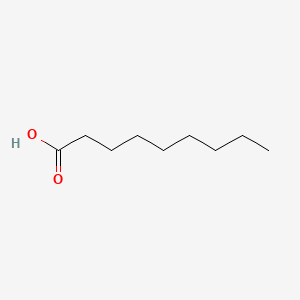| MeSH term | MeSH ID | Detail |
|---|---|---|
| Arteriosclerosis | D001161 | 86 associated lipids |
| Dermatitis, Contact | D003877 | 59 associated lipids |
| Facial Dermatoses | D005148 | 7 associated lipids |
| Hypersensitivity | D006967 | 22 associated lipids |
| Keratosis | D007642 | 9 associated lipids |
| Lichen Planus | D008010 | 3 associated lipids |
| Parakeratosis | D010241 | 1 associated lipids |
| Riboflavin Deficiency | D012257 | 10 associated lipids |
| Seizures | D012640 | 87 associated lipids |
| Tick Infestations | D013984 | 4 associated lipids |
NONANOIC ACID
NONANOIC ACID is a lipid of Fatty Acyls (FA) class. Nonanoic acid is associated with abnormalities such as megalocytosis, Hypos, Renal tubular disorder, Respiratory Distress Syndrome, Adult and Little's Disease. The involved functions are known as Gene Expression, Signal Transduction, Regulation, Cell Cycle and Force. Nonanoic acid often locates in Membrane, Protoplasm, Body tissue, Extracellular and Cell membrane. The associated genes with NONANOIC ACID are cysteinylglycine, glycylsarcosine, arginine methyl ester, GLI3 gene and ADRBK1 gene. The related lipids are 1-octen-3-ol, Butyric Acids, palmitoleic acid, pentadecanoic acid and stearic acid.
Cross Reference
Introduction
To understand associated biological information of NONANOIC ACID, we collected biological information of abnormalities, associated pathways, cellular/molecular locations, biological functions, related genes/proteins, lipids and common seen animal/experimental models with organized paragraphs from literatures.
What diseases are associated with NONANOIC ACID?
NONANOIC ACID is suspected in megalocytosis, Hypos, Renal tubular disorder, Respiratory Distress Syndrome, Adult, Little's Disease and other diseases in descending order of the highest number of associated sentences.
Related references are mostly published in these journals:
- Dis Model Mech (1)
- Am. J. Physiol. Heart Circ. Physiol. (1)
- Am. J. Physiol. Lung Cell Mol. Physiol. (1)
- Others (1)
| Disease | Cross reference | Weighted score | Related literature |
|---|
Possible diseases from mapped MeSH terms on references
We collected disease MeSH terms mapped to the references associated with NONANOIC ACID
PubChem Associated disorders and diseases
What pathways are associated with NONANOIC ACID
There are no associated biomedical information in the current reference collection.
PubChem Biomolecular Interactions and Pathways
Link to PubChem Biomolecular Interactions and PathwaysWhat cellular locations are associated with NONANOIC ACID?
Visualization in cellular structure
Associated locations are in red color. Not associated locations are in black.
Related references are published most in these journals:
| Location | Cross reference | Weighted score | Related literatures |
|---|
What functions are associated with NONANOIC ACID?
Related references are published most in these journals:
| Function | Cross reference | Weighted score | Related literatures |
|---|
What lipids are associated with NONANOIC ACID?
Related references are published most in these journals:
| Lipid concept | Cross reference | Weighted score | Related literatures |
|---|
What genes are associated with NONANOIC ACID?
Related references are published most in these journals:
| Gene | Cross reference | Weighted score | Related literatures |
|---|
What common seen animal models are associated with NONANOIC ACID?
There are no associated biomedical information in the current reference collection.
NCBI Entrez Crosslinks
All references with NONANOIC ACID
Download all related citations| Authors | Title | Published | Journal | PubMed Link |
|---|---|---|---|---|
| Jin CW et al. | Differential regulatory role of nitric oxide in mediating nitrate reductase activity in roots of tomato (Solanum lycocarpum). | 2009 | Ann. Bot. | pmid:19376780 |
| Reichler SA et al. | Intersection of two signalling pathways: extracellular nucleotides regulate pollen germination and pollen tube growth via nitric oxide. | 2009 | J. Exp. Bot. | pmid:19363208 |
| Yip KH et al. | Inhibition of anti-IgE mediated human mast cell activation by NO donors is dependent on their NO release kinetics. | 2009 | Br. J. Pharmacol. | pmid:19302592 |
| Jing P et al. | High lipophilicity of perfluoroalkyl carboxylate and sulfonate: implications for their membrane permeability. | 2009 | J. Am. Chem. Soc. | pmid:19170492 |
| Sukhonthara S et al. | Characterization of volatile aroma compounds from red and black rice bran. | 2009 | J Oleo Sci | pmid:19202314 |
| Jo YS et al. | Micelles for delivery of nitric oxide. | 2009 | J. Am. Chem. Soc. | pmid:19764751 |
| Muzaffar S et al. | Acute inhibition of superoxide formation and Rac1 activation by nitric oxide and iloprost in human vascular smooth muscle cells in response to the thromboxane A2 analogue, U46619. | 2008 Apr-May | Prostaglandins Leukot. Essent. Fatty Acids | pmid:18420399 |
| Ku HO et al. | Analysis of differential gene expression in auricular lymph nodes draining skin exposed to sensitizers and irritants. | 2008 | Toxicol. Lett. | pmid:18242016 |
| Suihko C and Serup J | Fluorescence confocal laser scanning microscopy for in vivo imaging of epidermal reactions to two experimental irritants. | 2008 | Skin Res Technol | pmid:18937788 |
| Clemmensen A et al. | The irritant potential of n-propanol (nonanoic acid vehicle) in cumulative skin irritation: a validation study of two different human in vivo test models. | 2008 | Skin Res Technol | pmid:19159372 |
